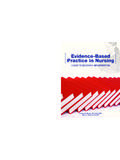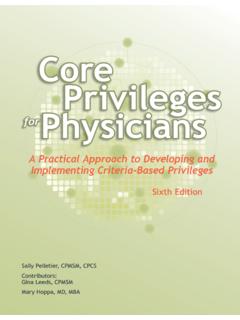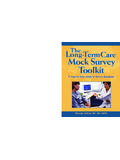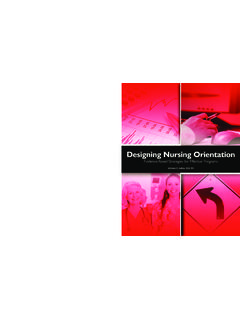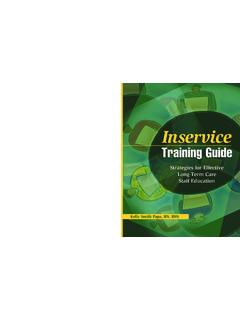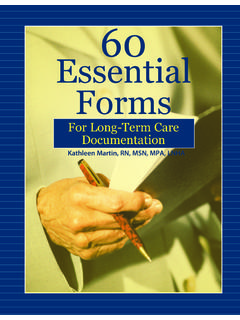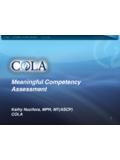Transcription of Proctoring, FPPE, and Competency Assessment …
1 100 Winners Circle, Suite 300 Brentwood, TN divisionof BL RTodd Sagin, MD, JDA clinical Leader s Guide Proctoring, FPPE, and Practitioner Competency AssessmentTodd Sagin, MD, JDProctoring, FPPE, and Practitioner Competenc yAssessment A clinical Leader s Guide Proctoring, FPPE, and Practitioner Compe t enc y Assessment SaginEven as regulators and the public demand more verification of physician competence, physicians have less time and are less willing to perform competence assessments and undergo monitoring. With this in mind, medical staffs must develop proctoring and precepting plans that are effective and efficient. Proctoring, FPPE, and Practitioner Competency Assessment : A clinical Leader s Guide outlines the steps involved in proctoring, best methods for proctoring, and how to complete assessments.
2 Author Todd Sagin, MD, JD, will help physician leaders and MSPs develop a proctoring program that physicians guide contains sample forms and checklists that medical staffs can use to conduct proctoring. MSPs and physician leaders will also find answers to common medical staff questions, such as the difference between proctoring and precepting, how ongoing professional practice evaluation (OPPE) and focused professional practice evaluation (FPPE) relate to proctoring, and how proctoring differs from peer 19/8/15 10:33 AMProctoring, FPPE, and Practitioner Competenc yAssessment A clinical Leader s Guide Todd Sagin, MD, JDProctoring, FPPE, and Practitioner Competency Assessment : A clinical Leader s Guide is published by HCPro, a division of 2015 HCPro, a division of BLRAll rights reserved. Printed in the United States of America.
3 5 4 3 2 1 ISBN: 978-1-55645-500-1No part of this publication may be reproduced, in any form or by any means, without prior written consent of HCPro or the Copyright Clearance Center (978-750-8400). Please notify us immediately if you have received an unauthorized provides information resources for the healthcare industry. HCPro is not affiliated in any way with The Joint Commission, which owns the JCAHO and Joint Commission Sagin, MD, JD, AuthorKaren Kondilis, EditorErin Callahan, Vice President, Product Development & Content StrategyElizabeth Petersen, Executive Vice President, HealthcareMatt Sharpe, Production SupervisorVincent Skyers, Design Services Director Vicki McMahan, Sr. Graphic DesignerMichael McCalip, Layout/Graphic DesignKelly Church, Cover DesignerAdvice given is general. Readers should consult professional counsel for specific legal, ethical, or clinical questions.
4 Arrangements can be made for quantity discounts. For more information, contact:HCPro100 Winners Circle Suite 300 Brentwood, TN 37027 Telephone: 800-650-6787 or 781-639-1872 Fax: 800-785-9212 Email: HCPro online at and HCPro 2015 Proctoring, FPPE, and Practitioner Competency AssessmentiiiContentsAbout the Author ..vAcknowledgments ..viiChapter 1: Assessing Practitioner Competency : A Growing Concern ..1 Assessing the Adequacy of Education and Training ..4 Role of State Medical Licensure ..6 Continuing Medical Education: A Common Requirement to Promote Competency ..7 Board Certification: An Appropriate Proxy for Competence? ..8 Accreditation Organizations and the Determination of clinical Competence ..12 Chapter 2: Proctoring as an Assessment Tool ..15 Types of Proctoring: A Competency Tactic in Several Flavors.
5 17 Chapter 3: What Is the Difference Between Proctoring and Precepting? ..53 Chapter 4: Addressing the Mechanics of and Selection of Proctors ..57 How Should Proctors Be Trained and Oriented? ..65 Obtaining Consent From Patients/Disclosure to Patients ..70 Should Proctors Be Paid? ..71 Proctoring Agreements ..73 Reporting Proctoring Results ..78 The Role of the MSP ..81 CONTENTSiv Proctoring, FPPE, and Practitioner Competency Assessment HCPro 2015 ContentsChapter 5: Legal Concerns Related to Proctoring, FPPE, and Medical Staff Competency Assessment Sues Over Peer Review/Proctoring Findings? ..83 Are Proctoring and Other Peer Review Findings Discoverable in Legal Proceedings? ..88 Are Proctors and Others Engaged in FPPE Protected From Legal Liability? ..90 How Should Medical Staffs Document and Retain FPPE Results?
6 92 Can a Law Firm Request a Focused Review in Order to Further Protect the Review From Discovery in Legal Proceedings? ..93 How Should FPPE Results Be Transmitted Within the Medical Staff Organization? ..94 Reporting Obligations to the National Practitioner Data Bank ..94 Ethical Issues Relating to Proctoring and FPPE ..100 Chapter 6: Focused Professional Practice Evaluation ..109 FPPE of Initially Requested Privileges ..110 FPPE for an Identified Performance Concern ..114 FPPE for Low-Volume Practitioners ..117 FPPE for New Technology ..118 Carrying Out FPPE ..119 Adopting an FPPE Policy ..120 Sample Policies and Draft Forms to Facilitate FPPE ..125 Chapter 7: Additional Resources for Practitioner Competency Assessment ..141 Post-Licensure Assessment System Testing ..141 Simulated/Standardized Patients.
7 143 clinical Preceptorship ..144 Simulation Laboratories ..145 Conclusions ..147 Appendix A ..149 HCPro 2015 Proctoring, FPPE, and Practitioner Competency AssessmentvAbout the AuthorTodd Sagin, MD, JDTodd Sagin, MD, JD, is a physician executive recognized across the nation for his work with hospital boards, med-ical staffs, and physician organizations. He is the national medical director of Sagin Healthcare Consulting, LLC, and HG Healthcare Consultants, LLC, which provide guidance on a wide range of healthcare issues. He served for more than half a decade as the vice president and national medical director of The Greeley Company, Inc. Dr. Sagin is a practicing family physician and geriatrician who has held executive positions in academic and community hospitals and in organized medicine. He frequently lectures and facilitates retreats on medical staff affairs, physician leadership skills, relationships between hospitals and doctors, strategic healthcare planning, governance, and related topics.
8 HCPro 2015 Proctoring, FPPE, and Practitioner Competency AssessmentviiAcknowledgmentsI have been fortunate in my many years of practice and consulting work to have interacted and learned from an amazing group of colleagues and mentors. I have been influenced in different ways by each of them and they have helped me grow professionally in both measurable and immeasurable ways. One of the real joys of the work I do is that I continue to meet so many talented and admirable people working to improve the healthcare field. To all such individuals I have already met and to those I have yet to meet, I dedicate this book. HCPro 2015 Proctoring, FPPE, and Practitioner Competency Assessment1 CHAPTER 1 Assessing Practitioner Competency : A Growing ConcernPractitioner Competency is the sine qua non of good quality healthcare.
9 Unfortu-nately, the past two decades have produced a mountain of data demonstrating that our hospitals and other care facilities deliver medical treatment that is frequently inadequate, inappropriate, and unsafe. The public focus on these concerns ramped up in 1998 following the Institute of Medicine report titled To Err Is Human: Build-ing a Safer Health At that time, the medical world was stunned by data that suggested as many as 98,000 patients annually died in hospitals from prevent-able medical errors. In the years since that seminal publication, further research has validated that medical errors are common occurrences in healthcare These results have gotten the attention of the public, patients, politicians, employers, and payers and have eroded the reputation of the healthcare field in general. Nevertheless, surveys reveal that most patients have great faith in their personal physicians.
10 The many tactics being deployed by health enterprises to achieve excellent and safe care become less critical when these organizations are diligent in allowing only highly competent personnel to treat patients. Not only do good practitioners personally render good care, but they also attend to the secondary causes of 2 Proctoring, FPPE, and Practitioner Competency Assessment HCPro 2015 Chapter 1diminished quality, such as weak clinical processes, poor deployment of technol-ogy, unacceptable variances in results, and colleagues who aren t practicing at an acceptable level. To what extent are healthcare quality and safety problems a function of poor practitioner competence? No one knows. American medical schools and residency programs are highly regarded for their rigor, but in many academic institutions, education seems to take a back seat to research priorities and the need to generate clinical revenue.
